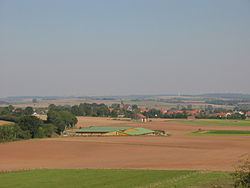Country Germany Area 3 km² Dialling code 05644 | Time zone CET/CEST (UTC+1/+2) Postal code 34439 Administrative region Detmold | |
 | ||
Eissen is a Westphalian village with 718 inhabitants in North Rhine-Westphalia and part of the town of Willebadessen, district Höxter in the administrative region of Detmold.
Contents
- Map of Eissen 34439 Willebadessen Germany
- Name
- Coat of arms
- Geographical position
- Neighbouring places
- History
- Demographics
- Religion
- Politics
- Economy
- Transportation
- Regular Events
- Clubs
- Literature
- References
Map of Eissen, 34439 Willebadessen, Germany
Name
Eissen has passed through a long evolution. Starting in the early Middle Ages with Aieshusun (the ending -husun points to Saxon time) during the High Middle Ages' name Heisten to today 's form Eissen.
Concerning the meaning of each name there are different theories, but none of them is proven:
Coat of arms
The coat of arms was designed and introduced in 1996. Initiated by the St. Liborius Schützenverein, the coat of arms itself should integrate the so-called Taufsteinwappen, an old coat of arms on the church's baptismal font, and symbols that represent the patron Saint Liborius.
The Taufsteinwappen, placed in the bottom part's centre, is headed by the lettering "1080", because for that year a monastery farm of Corvey Abbey is proven for the first time in Eissen. The Latin words "Villa Aeissun" at the bottom belong to a deed which was written in the monastery of Helmarshausen. In this deed Eissen was mentioned. In the middle part are three green bows, which point to the chaplet of tilia which is found in front of Eissen's church.
Geographical position
Eissen is located at the northern border of the Warburger Börde at a gently inclined place. While the railway station is at an altitude of 221 metres, the Eissener Höhe in the north between Peckelsheim and Eissen rises to 247 metres. To the south of the railway station the terrain falls as far as the church and further to the lower village. In the southwest a volcanic hill rises up 250 metres, the Hüssenberg.
Neighbouring places
To the northwest lies Peckelsheim, to the north Schweckhausen, Willegassen and Schönthal, to the east Borgentreich, to the southeast Lütgeneder, to the south Großender, to the southwest Engar and Deppenhöfen and to the west Löwen.
History
Demographics
With 780 inhabitants, Eissen is the third largest locality in the municipal area of Willebadessen. In the year 1760 the population of Eissen amounted to 360 inhabitants. Between 1818 and 1890, 110 inhabitants emigrated, most of them to the United States of America and the United Kingdom of Great Britain and Ireland, but also to Sweden and the Caribbean.
Religion
The biggest religion is the Catholic Church of St. Liborius, counting 649 members, which belongs to the parish cluster Willebadessen-Peckelsheim. The church is part of the deanery Höxter in the Archdiocese of Paderborn. The Lutherans belongs to the Lutheran Church of Peckelsheim.
Politics
Since the rearrangement of the townships in North Rhine-Westphalia in 1975, Eissen is no more an independent community. Eissen now belongs to the municipal area of Willebadessen and is represented on city council by one direct member. Since the last local election in September 2004, three people from Eissen are members of the city council (CDU: 2, SPD:1).
Economy
Eissen is agricultural and craftsmanship. In the village there are some small craftmans' establishments, service companies and businesses concerning the fields of metal working, construction, wood and food. Located at the edge of the fertile plain "Warburger Börde", in relation to other German regions, farming has a slightly major role, but concentration in this sector is also ongoing. Organic farming has a superior quota of the farmed cropland and provides additional jobs in labour-intensive areas.
Many of the Eisseners are working in the cities Warburg, Brakel, Höxter and Beverungen.
Transportation
Via the state route L763 toward Peckelsheim, Eissen is connected to federal route B 252. In the other direction, the L763 leads to Borgentreich, where access is provided to the B 241. Warburg station and Paderborn Central Station are served by Intercity services, Willebadessen and Brakel station are served by Regionalbahn trains. Paderborn Lippstadt Airport is 50 km distant.
Regular Events
Clubs
Literature
Aieshusun - Aeissun - Eysnen - Eissen Bild unserer Heimat, Released by St. Liborius-Schützenverein Eissen Selbstverlag/NEWSPOINT-Medienservice Uwe Rottkamp, Bad Salzuflen 2003
